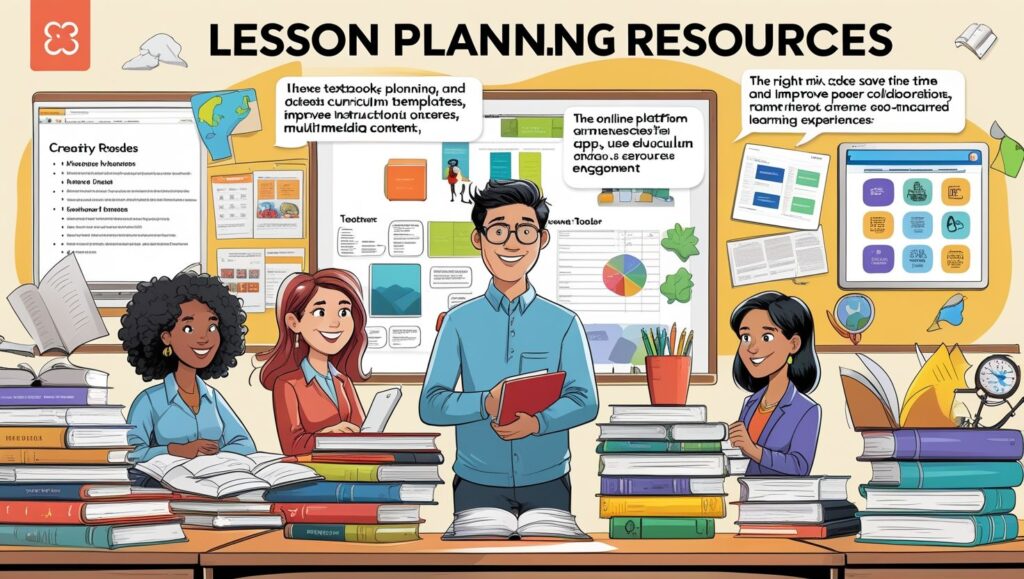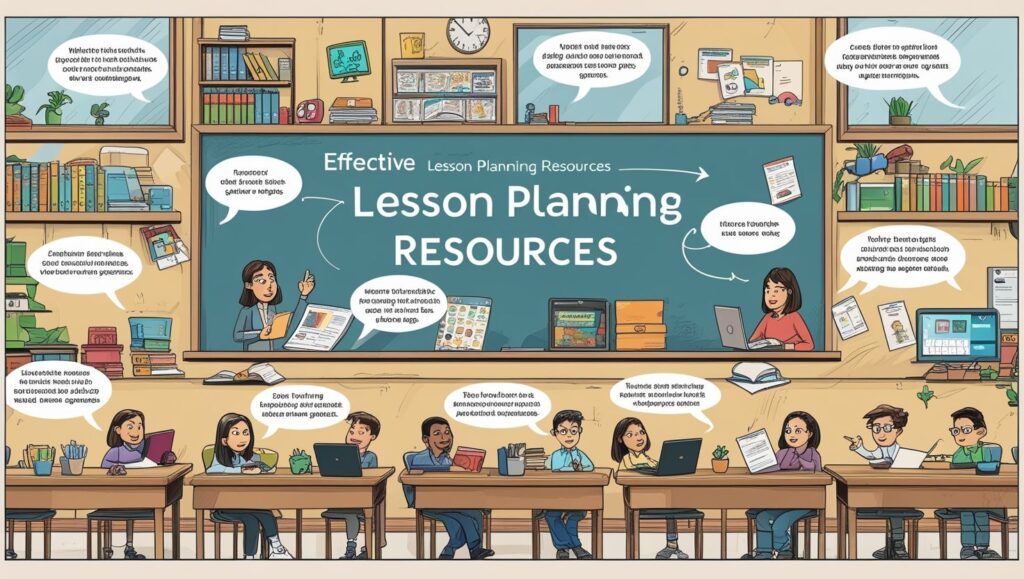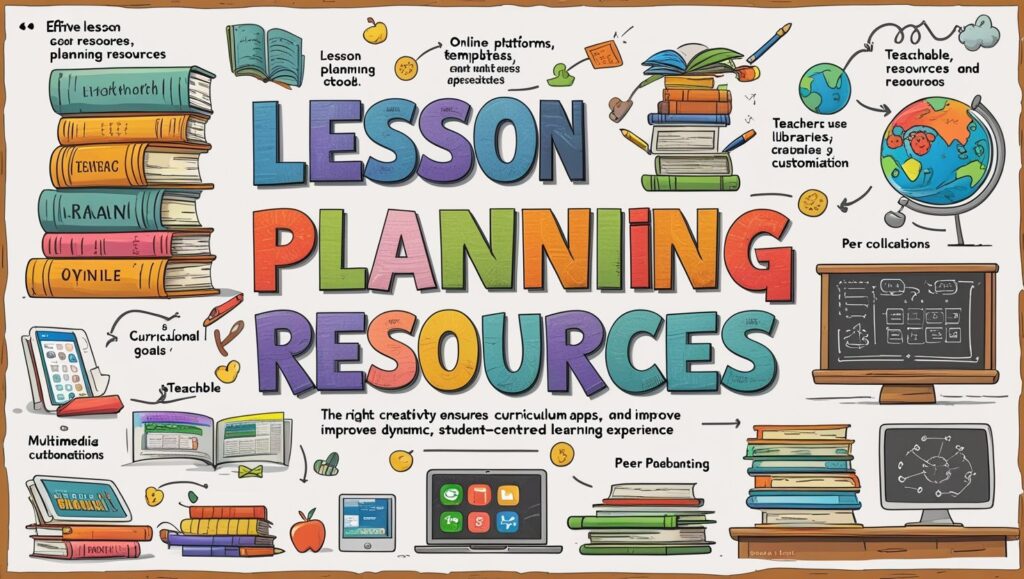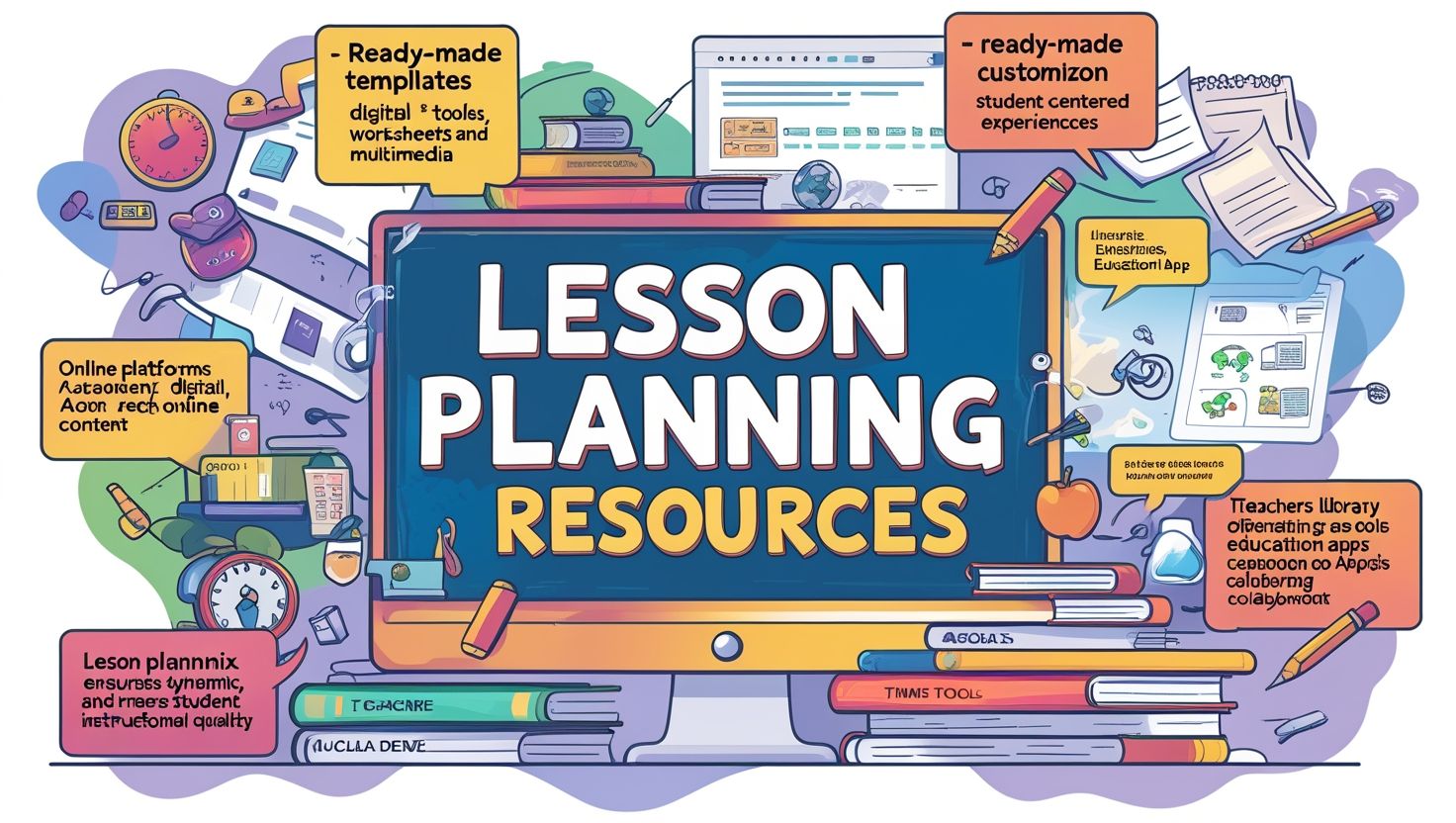Introduction:
“Lesson Planning Resources”, Lesson planning is the backbone of effective teaching. It guides classroom activities and ensures that learning goals are met. Therefore, quality lesson planning resources are essential for teachers. They help educators prepare content, align objectives, and manage time. Without such tools, teaching becomes disorganized and ineffective.
Moreover, lesson planning resources save time. Instead of starting from scratch, teachers can use existing templates, guides, and strategies. These tools help in structuring lessons, choosing the right materials, and setting appropriate assessments. For new teachers, they offer direction. For experienced teachers, they provide inspiration. Additionally, resources promote consistency in teaching. Schools and institutions can ensure all students receive a balanced education. Furthermore, with modern digital tools, resources have become more accessible. Teachers can now download, customize, and share plans with ease.
However, not all resources are equally effective. It is important to choose those that suit students’ needs and learning levels. Teachers must evaluate and adapt them accordingly. Thus, resource selection is as important as the planning itself. In conclusion, lesson planning resources empower teachers. They make teaching more organized, focused, and impactful. Through this article, we will explore different types, benefits, and best practices for using these resources effectively.
Types of Lesson Planning Resources
There are many types of lesson planning resources available today. Teachers can select based on their subject, class level, or teaching style. First, we have lesson plan templates. These are structured formats that guide teachers in writing their plans. They usually include sections for objectives, materials, procedures, and assessments. Secondly, there are curriculum guides. These offer broad outlines of what to teach across a term or year. While templates help with daily lessons, curriculum guides ensure alignment with academic standards. They are often provided by schools or education departments.
Thirdly, teaching manuals are very helpful. They include detailed lesson explanations and suggested activities. Many publishers provide manuals with their textbooks. These resources make teaching easier and more consistent. In addition, online platforms have become very popular. Websites and apps offer digital lesson planning tools. For example, teachers can find interactive lesson plans, editable templates, and video tutorials. These platforms are regularly updated.
Also, some teachers use collaborative tools like shared folders or Google Docs. They plan lessons with their colleagues. This encourages teamwork and idea-sharing. Therefore, with so many options, teachers can choose what suits them best. The key is to use the right resource at the right time.

Digital Tools for Effective Lesson Planning
Technology has transformed lesson planning. Digital tools are now a teacher’s best friend. They offer convenience, efficiency, and creativity. One popular tool is Google Classroom. It allows teachers to plan, assign, and organize lessons online. Moreover, teachers can share resources with students instantly. Similarly, Microsoft OneNote helps in organizing lesson notes. Teachers can add images, links, and even audio. It becomes a virtual lesson planner. Additionally, tools like Planboard and Trello offer drag-and-drop features for easy scheduling.
Another valuable digital resource is Teachers Pay Teachers (TPT). It offers ready-made lesson plans created by other teachers. These plans are editable and customizable. Thus, teachers can save time and still deliver quality lessons. Moreover, interactive whiteboard software like Jamboard and SMART Notebook allows dynamic lesson planning. These tools help in visualizing content during delivery.
Furthermore, many mobile apps now support lesson planning on the go. Apps like EduPage and Planbook allow planning directly from smartphones. They sync across devices, ensuring access anywhere. However, teachers must ensure digital tools align with their curriculum goals. They should not replace good planning but enhance it. Therefore, integrating digital tools smartly makes lesson planning faster and more effective.
Benefits of Using Structured Lesson Planning Resources
Using structured resources provides numerous advantages. Firstly, it brings clarity. Teachers know what to teach and how to teach it. Secondly, it saves time. Instead of spending hours planning from scratch, teachers can rely on pre-designed formats. This boosts efficiency. Moreover, resources ensure consistency. Students across classes receive the same content. As a result, educational equity improves. Furthermore, structured plans support curriculum alignment. Teachers can match lesson goals with national standards and learning outcomes.
In addition, resources help with assessment planning. They include questions, quizzes, and evaluation strategies. This ensures that teaching and testing go hand-in-hand. Structured plans also support classroom management. With clear steps, transitions between activities become smooth. This reduces downtime and keeps students engaged.
Also, they support teacher development. Reviewing well-designed plans gives teachers new ideas. They learn different teaching strategies and classroom techniques. However, one must avoid over-dependence. Plans should not become rigid. Teachers must still observe students’ needs and adjust when necessary. In summary, structured lesson planning resources bring order and effectiveness. When used wisely, they enhance the teaching process, save time, and improve learning results.

Subject-Specific Lesson Planning Resources
Every subject requires a unique approach. Therefore, lesson planning resources must be subject-specific. For example, math teachers need resources with step-by-step problem-solving activities. They often use visual aids and manipulatives. Websites like Khan Academy offer such plans with videos and practice exercises.
On the other hand, language teachers focus on grammar, reading, and writing. Resources include storybooks, vocabulary lists, and writing prompts. Additionally, listening exercises enhance speaking skills. In science, hands-on experiments and observation tasks are vital. Therefore, teachers use lab manuals, science kits, and demonstration videos. Websites like PhET Interactive Simulations offer engaging tools for lesson planning in science.
Similarly, social studies lesson plans often include maps, timelines, and case studies. Teachers might use documentaries or role-play activities. These help students understand historical and cultural topics. Art, music, and physical education also have unique needs. Teachers rely on visuals, audio files, and physical activities. Thus, planning for these subjects involves creativity.
Therefore, choosing the right subject-specific resources improves lesson effectiveness. Teachers should explore both traditional and digital options. In conclusion, matching the resource to the subject is key to successful lesson delivery.
How to Evaluate and Select the Right Resources
Choosing the right lesson planning resources is crucial. Not all resources are equally helpful. Therefore, teachers must evaluate them before use. First, they should check curriculum alignment. Does the resource support learning objectives? If not, it may confuse students. Secondly, content accuracy matters. Resources must be factually correct and up-to-date. Outdated material can mislead students. Thirdly, the usability of the resource is important. Is the layout clear? Are instructions easy to follow?
Additionally, consider student engagement. Will the resource capture students’ interest? Interactive and visual content often works better. Teachers should also look for flexibility. Can the resource be modified? If yes, it allows adjustments for different learning levels. Moreover, peer reviews help. Resources with positive feedback from other teachers are usually reliable. Online platforms often have ratings and comments. These give a good idea about effectiveness.
Also, consider cultural relevance. A resource should respect student backgrounds and values. This makes learning more inclusive. Lastly, cost is a factor. Free or low-cost resources are widely available. However, quality should not be compromised. In short, proper evaluation ensures that the selected resource truly supports learning. Therefore, choosing wisely is part of smart lesson planning.
Collaborative Lesson Planning Among Teachers
Working together enhances lesson planning. When teachers collaborate, they share ideas, strategies, and challenges. This leads to better resource selection and lesson delivery. Moreover, collaboration promotes consistency. If multiple teachers teach the same subject, planning together ensures similar content coverage.
Additionally, it reduces workload. One teacher may create slides, another designs worksheets, and a third plans assessments. Together, they build a complete lesson plan. This division of tasks saves time. Furthermore, collaboration supports professional growth. Teachers learn from each other. They explore different teaching methods. For example, one might suggest using drama in a history lesson. Another might recommend digital quizzes for review.
Teachers can collaborate during weekly meetings or through online platforms. Shared folders, Google Docs, and school intranets make it easy to work as a team. In some schools, Professional Learning Communities (PLCs) support ongoing planning. However, collaboration requires coordination. Teachers must agree on objectives and timelines. Respect and communication are key. Therefore, collaborative planning is powerful. It leads to better outcomes for both teachers and students. When minds come together, lesson plans become more creative, efficient, and effective.

Challenges in Using Lesson Planning Resources
Despite the benefits, using lesson planning resources can be challenging. Firstly, there is resource overload. Too many options can confuse teachers. Selecting the right one becomes difficult. Secondly, inflexible resources may not suit all students. If content is too rigid, it cannot be adapted. Moreover, technology issues often arise. Some teachers may lack digital skills. Others may have limited internet access. This makes it hard to use online resources effectively.
Additionally, lack of time is a big issue. Teachers are often too busy to explore or customize resources. As a result, they may stick to old plans. This reduces lesson freshness and engagement. Some teachers also face language barriers. Resources in a different language may be hard to understand or translate. Furthermore, limited school support can hinder usage. Schools may not provide training or access to paid platforms.
Lastly, resistance to change exists. Some educators prefer traditional methods. They may not see the need to use new resources. Therefore, addressing these challenges is important. Schools must support teachers with time, training, and access. With the right help, resource usage can become smooth and effective.
Conclusion:
Lesson planning resources are valuable tools for teachers. They simplify preparation, improve lesson quality, and enhance student learning. Whether they are printed guides, digital tools, or shared templates, each type offers benefits. However, they must be chosen and used wisely. Moreover, teachers should match resources to student needs. They must consider age, subject, and learning style. Flexibility is key. A rigid resource may not suit all students. Therefore, adaptation is necessary.
Additionally, technology offers endless possibilities. Online platforms, mobile apps, and collaborative tools make planning easier. Still, digital literacy is important. Teachers should be trained to use these tools effectively. Also, working together helps. Collaborative planning brings better ideas and reduces workload. Teachers grow professionally and students benefit more.
Yet, challenges exist. Time limits, lack of access, or too many options can confuse teachers. Hence, schools must support them with guidance and tools. In conclusion, lesson planning resources are essential in modern education. They support teachers in delivering high-quality, engaging, and effective lessons. By selecting the right tools, evaluating carefully, and collaborating with others, teachers can make the most of these valuable aids.

Your tips are practical and easy to apply. Thanks a lot!
I appreciate your unique perspective on this.
I agree with your point of view and found this very insightful.
Your writing always inspires me to learn more.
I really appreciate content like this—it’s clear, informative, and actually helpful. Definitely worth reading!
I really appreciate content like this—it’s clear, informative, and actually helpful. Definitely worth reading!
Zümrütevler su kaçak tespiti Ticari binalar daha sık kaçak muayenesi gerektirir. https://www.hockeynhlforum.com/read-blog/40384
Menderes su kaçak tespiti Evimi Kırmadan Sorunu Çözdüler: Kırmadan su kaçağı tespiti hizmeti almak çok büyük bir kolaylık. Banyomuzda hiçbir yeri kırmadan problemi buldular. https://avchats.com/read-blog/214
Ракетка https://igra-raketka-na-dengi.online/
İstanbul kırmadan su kaçak bulma Ekip işini titizlikle yapıyor, çok memnun kaldım. https://freedost.com/read-blog/8900
Alibeyköy su kaçak tespiti Çatalca’daki eski binamızda su kaçağını bulmaları çok zordu ama ekibin cihazları çok etkili. https://www.ayuujk.com/read-blog/10739
np02sg
xltv9j
yht3ht
6quos3
Happy to explore discussions, exchange ideas, and pick up new insights as I go.
I like understanding different opinions and contributing whenever I can. Interested in hearing different experiences and meeting like-minded people.
Here’s my web-site:AutoMisto24
https://automisto24.com.ua/
Of course, what a great site and revealing posts, I surely will bookmark your website.Best Regards!
Its wonderful as your other posts : D, regards for posting.
Thanks for sharing excellent informations. Your web site is so cool. I am impressed by the details that you¦ve on this site. It reveals how nicely you understand this subject. Bookmarked this website page, will come back for extra articles. You, my pal, ROCK! I found simply the information I already searched all over the place and simply couldn’t come across. What a perfect web-site.
Excellent items from you, man. I’ve consider your stuff prior to and you are simply too great. I actually like what you’ve acquired here, certainly like what you’re saying and the way wherein you say it. You make it entertaining and you continue to care for to stay it sensible. I cant wait to read much more from you. That is really a terrific web site.
Rattling nice design and style and good content material, practically nothing else we require : D.